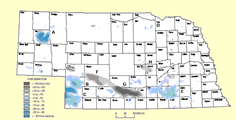Natural Resources, School of

Conservation and Survey Division: Faculty and Staff Publications
Document Type
Article
Date of this Version
7-1942
Citation
Tolstead, William L. 1942. Vegetation of the Northern Part of Cherry County, Nebraska. Ecological Monographs 12(3): 256-292. Conservation and Survey Division and the Department of Botany, University of Nebraska.
Abstract
Agricultural practices in the Great Plains of North America are now in a period of adjustment from a traditional agriculture initiated by pioneer farmers to a grazing economy based upon potentialities of climate and soil. The attainment of a proper system of land use has been retarded in many localities by the lack of definite information concerning the vegetation and its indicator significance. In this study of the vegetation of Cherry County, Nebraska, the interrelations between the plants and their environments are discussed, the dominant species are described, and changes in grasslands caused by seasons, grazing, and climatic cycles are explained.
Cherry County, which is located in north-central Nebraska, extends from 100°10′ to 102°2′ west longitude and from 42°7′ to 43° north latitude, distances of 96 and 63 miles, respectively. It is the largest county in Nebraska and includes an area of 6,048 square miles. More than 90 percent of this area lies in the sand-hill region. The remainder (the hardlands) consists of fine sandy loam soils, the main body of which is north of the Niobrara River and northeast of Minnechaduza Creek.
A study of the vegetation of the sand hills of Nebraska was first made by Pool (1914). Reviews of pioneer work on the taxonomy of various species may be found in his paper. Since then few studies have been made. Weaver (1920) described root systems of certain sand-hill plants, and Keim and Frolik (1932) studied the introduction of exotic legumes and grasses into wet meadows and recorded the effects upon productivity. Ramaley (1939) made a study of the flora of the sand hills of northeastern Colorado and compared it with the sand-hill flora of Nebraska.
According to information obtained from pioneers who are yet living, the dunes were not as well vegetated in the early years of settlement as they are at present. Blowouts were more common, and pioneer vegetation was more prevalent. An early resident stated that sand-hill bluestem (Andropogon hallii Hack.) was much more common than it is today. Little bluestem (Andropogon scoparius Michx.) was once dominant and led Pool (1913) to describe a “bunch-grass association.” Early pictures verify Pool’s conclusions (Anderson & Walker 1920) and also indicate that blowout grass (Redfieldia flexuosa ( Thurb.) Vasey) and weedy plants like soapweed (Yucca glaiica Nutt.) were once very common.
Changes in vegetation of the sand hills since their settlement by white men have accompanied the control of fires, and differences in land use and intensity of grazing. Before the development of ranching, prairie fires occurred throughout the region at varying intervals. These fires spread rapidly and generated intense heat wherever sufficient debris had accumulated. Buds were killed, even in the centers of the bunches of grass, and roots were burned. Severe wind erosion followed denudation, and most dunes were permanently capped with a blowout. After each fire pioneer grasses and forbs began a new succession of plants. Only after several years was enough litter again accumulated to feed new fires. Since the beginning of the present century grazing has checked this accumulation, and therefore fires have been under control. Dunes are now held in place and large blowouts are rare. Variation in composition of vegetation is now caused by grazing and local environments.
Areas of vegetation on government preserves or on private ranges which have been protected from both fire and grazing for many years indicate the potentialities of development of vegetation in the several environments. Modifications of composition regularly accompany shifts from one phase of the climatic cycle to another. The decrease of little bluestem during the recent dry years is a striking example.
Included in
Biodiversity Commons, Horticulture Commons, Hydrology Commons, Other Plant Sciences Commons, Soil Science Commons

